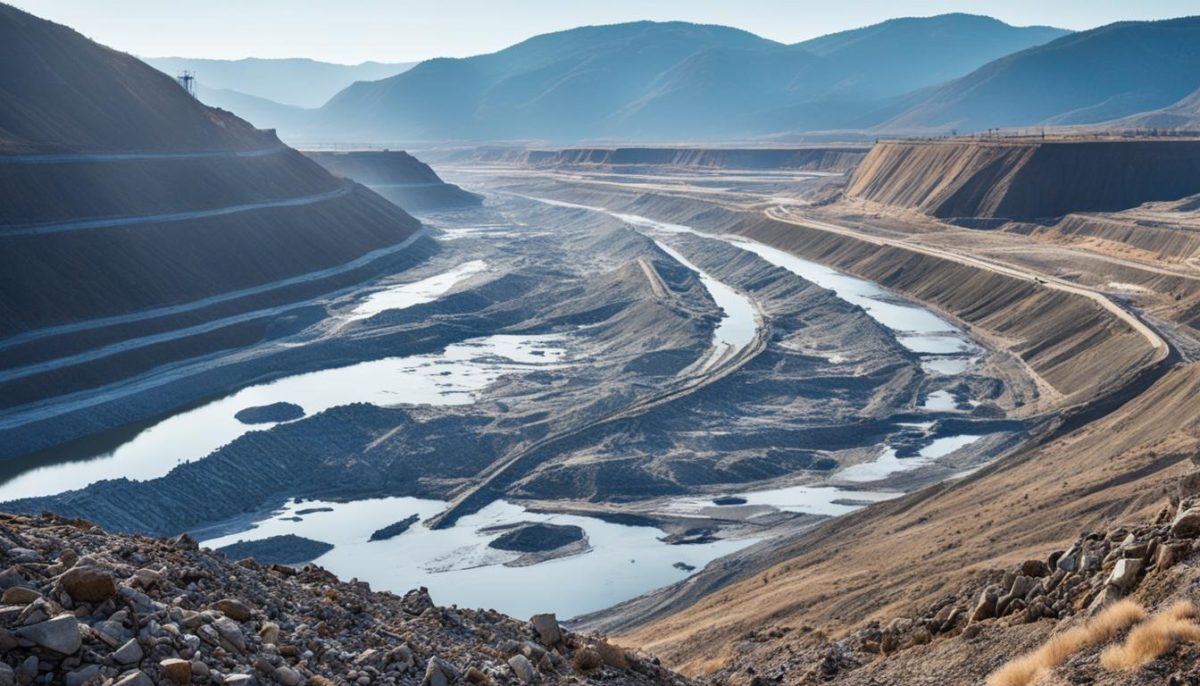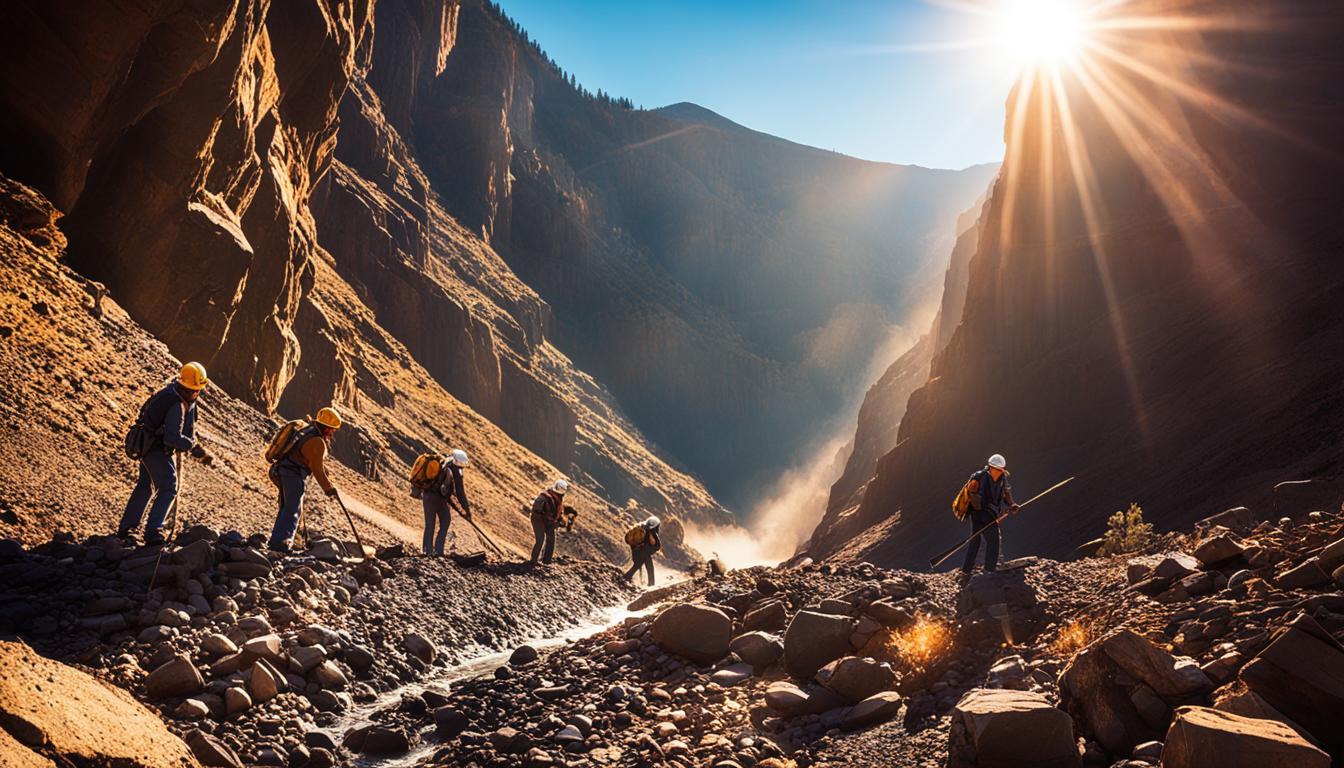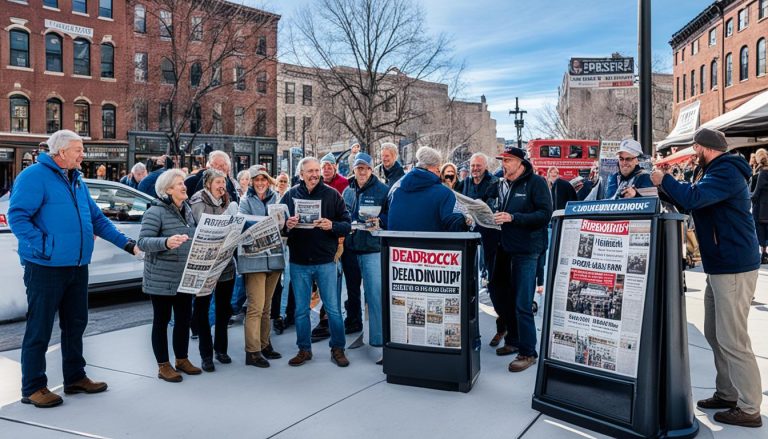Welcome to my exploration of the Mining Divide in Deadrock! In this section, we’ll dive into the challenges and landscapes that define this unique region. Here, miners and the environment find themselves locked in a clash, creating tensions and circumstances that demand closer examination.
The Mining Divide in Deadrock presents a fascinating juxtaposition of interests. On one hand, we have the miners, driven by economic necessity and the pursuit of valuable resources. And on the other, we have the environment, an intricate ecosystem that holds both beauty and fragility.
As we delve deeper into this topic, we’ll uncover the complexities that arise when miners and the environment collide. The rugged landscapes of Deadrock set the stage for a battle between the pursuit of livelihood and the preservation of nature.
Our journey will take us through the history of mining in Deadrock, the effects of mining on the environment, the unique challenges faced by miners, and the search for sustainable solutions. By understanding these dynamics, we can shed light on ways to bridge the divide and ensure a harmonious coexistence between industry and nature.
So join me as we embark on this exploration of the Mining Divide in Deadrock. Together, we’ll uncover the stories, struggles, and potential for finding common ground in this fascinating region.
The History of Mining in Deadrock
Welcome to the fascinating history of mining in Deadrock. This region has a rich legacy of mining that has played a significant role in shaping the community and landscape of the Mining Divide.
The origins of mining in Deadrock date back to the mid-1800s. It all began with the discovery of precious minerals and metals deep within the earth’s crust. Prospectors from all walks of life flocked to the region in search of fortune, fueling a mining boom that forever changed the face of Deadrock.
The first major discovery in Deadrock was gold. Prospectors struck gold in abundance, leading to the establishment of numerous mining camps throughout the area. This initial gold rush attracted thousands of miners who sought to capitalize on the newfound wealth. As more people arrived, a bustling community began to take shape around the mining activities.
Over time, the focus of mining in Deadrock shifted from gold to other valuable resources. Silver, copper, and coal became primary targets for extraction. Technological advancements and increased investment in mining operations allowed for more efficient and widespread mining activities. As a result, Deadrock’s mining industry flourished, attracting even more individuals seeking employment and economic opportunities.
The significance of mining in Deadrock cannot be overstated. It not only fueled the local economy but also shaped the identity of the region. Mining became intertwined with the daily lives of the residents, creating a unique culture and sense of community among the miners.
As mining continued to expand, it brought both prosperity and challenges to Deadrock. The need for infrastructure development, such as railways and roads, became apparent to support the growing industry. At the same time, environmental concerns arose as mining activities had a significant impact on the surrounding ecosystems.
The history of mining in Deadrock is a complex tapestry of triumphs, hardships, and enduring legacies. In the next section, we will delve into the environmental impact and concerns associated with the mining activities in the Mining Divide.
Environmental Impact and Concerns
Mining activities in the Mining Divide have significant environmental impact, raising legitimate concerns about the long-term sustainability of the region. The delicate ecosystem and diverse wildlife habitats are under threat due to the exploitation of natural resources.
As mining operations continue to expand, the delicate balance between exploitation and preservation becomes increasingly difficult to maintain. The extraction of precious minerals and metals from the earth has far-reaching consequences on the surrounding environment, jeopardizing the biodiversity and overall health of the area.
One of the primary concerns is the destruction of habitats necessary to support local wildlife populations. The disruption caused by mining activities disrupts the natural food chain, leading to a decline in certain species. Additionally, the release of pollutants and hazardous substances during the mining process poses risks to both wildlife and human populations in the vicinity.
To address these concerns, strict environmental regulations and initiatives have been implemented to minimize the impact of mining operations. These regulations aim to monitor and control the release of harmful substances into the environment, ensure proper waste management, and encourage the adoption of sustainable mining practices.
“It is crucial that we strike a balance between reaping the economic benefits of mining and protecting the environment. By implementing robust regulations and embracing sustainable practices, we can mitigate the environmental impact and secure a better future for both the Mining Divide and its inhabitants.”
The Mining Divide presents a unique challenge, requiring ongoing vigilance and commitment from all stakeholders involved. While mining is integral to the local economy and provides employment opportunities, it is vital to find sustainable solutions that bridge the gap between the needs of industry and the preservation of nature.
The Effects of Mining on the Local Ecosystem:
- Destruction of wildlife habitats
- Disruption of the natural food chain
- Potential extinction of certain species
- Release of pollutants and hazardous substances
Environmental Regulations and Initiatives:
| Regulations and Initiatives | Description |
|---|---|
| Environmental Impact Assessments (EIAs) | Analyze potential environmental effects of proposed mining projects and recommend mitigation measures. |
| Restrictions on Pollution Emissions | Set limits on the amount of pollutants that mining operations are allowed to release into the air, water, and soil. |
| Rehabilitation Requirements | Monitor and enforce the restoration of mining sites to their pre-mining condition, including reclamation of land and water bodies. |
| Sustainable Mining Practices | Promote the use of advanced technologies and responsible mining methods that minimize environmental impact. |

The image above visually represents the environmental impact and concerns associated with mining in the Mining Divide, emphasizing the need for sustainable practices and environmental preservation.
The Life of a Miner in the Mining Divide
Living and working in the Mining Divide comes with its own set of challenges and experiences for miners. From the rugged landscapes to the intense daily routines, their lives are intricately entwined with the world beneath the surface.
Working conditions in the Mining Divide can be grueling. Miners brave the depths of the earth, confronting physical and psychological demands that require unwavering resilience. Each day, they descend into the depths, navigating through narrow tunnels, enduring extreme temperatures, and often working in hazardous environments.
Their work is not without risks. The Mining Divide poses its own dangers, with collapses, cave-ins, and gas leaks being constant threats. However, the camaraderie and dedication among miners foster a strong sense of community and mutual support. Trust and teamwork are essential in ensuring the safety of all involved.
The physically demanding nature of the profession takes its toll on miners’ bodies. Constant physical exertion, long hours, and exposure to dust and noise contribute to health issues, such as respiratory problems and hearing loss. However, miners continue to persevere, driven by their commitment to their livelihoods and the community.
Despite the challenges, the life of a miner in the Mining Divide also has its rewards. The thrill of discovery when uncovering precious minerals or valuable resources creates a sense of achievement and purpose. Miners are integral to the region’s economic growth and play a vital role in sustaining local communities.
| Challenges Faced by Miners | Rewards of Mining |
|---|---|
| Physical and psychological demands | Thrill of discovery |
| Hazardous working conditions | Economic growth for local communities |
| Health risks and exposure | Sense of achievement and purpose |
| Constant threat of accidents | Strong sense of community and camaraderie |
Despite the hardships and sacrifices, miners in the Mining Divide continue to hold their profession with pride and dedication. Their resilience serves as a testament to their character and their contribution, not only to the industry but also to the communities they call home.
Seeking Solutions and Bridging the Divide
The Mining Divide is a challenging landscape that demands innovative solutions and collaboration between miners and environmentalists. Finding a common ground is essential to ensure the sustainability of mining practices while preserving the natural beauty and biodiversity of the region.
One of the key strategies in bridging this divide is the adoption of sustainable mining practices. By implementing environmentally-friendly technologies and techniques, miners can minimize their impact on the ecosystem. From using renewable energy sources to reducing water usage and waste, these solutions can help strike a balance between industry and nature.
Collaboration between stakeholders is another crucial aspect of bridging the divide. Engaging with local communities, environmental organizations, and governmental bodies is vital to foster understanding, address concerns, and develop effective solutions. By working together, we can create a harmonious relationship where the mining industry can thrive responsibly while preserving the unique environment of the Mining Divide.
When seeking solutions, it is also important to consider the economic implications. The Mining Divide not only contributes significantly to the local economy but also provides job opportunities for many miners. By finding a balance between mining and environmental concerns, we can ensure the long-term sustainability of both the industry and the region, safeguarding the livelihoods of miners while protecting the natural resources that support their work.





